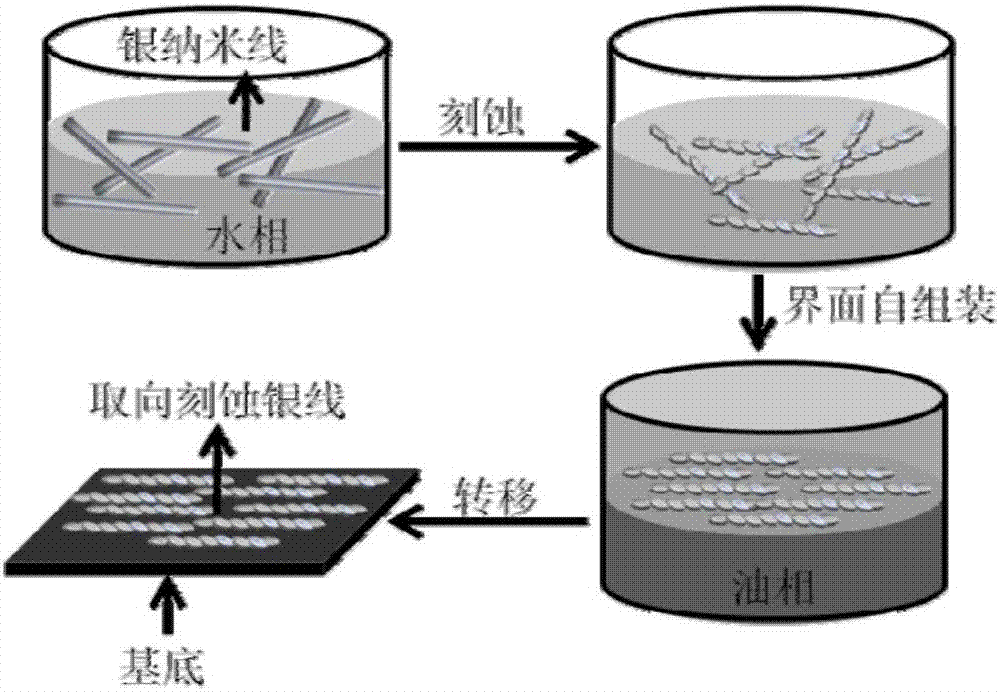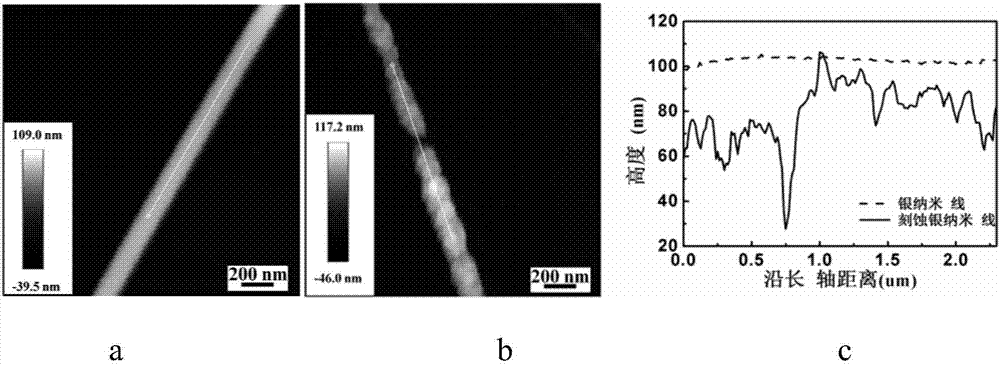Surface-enhanced Raman scattering substrate, and preparation method and application of surface-enhanced Raman scattering substrate
A surface-enhanced Raman and substrate technology, applied in the field of nanoscience, can solve the problems of limited wide application, poor signal re-linearity, uneven surface signal, etc., and achieve the effect of wide application prospect, high reproducibility and good detection sensitivity.
- Summary
- Abstract
- Description
- Claims
- Application Information
AI Technical Summary
Problems solved by technology
Method used
Image
Examples
Embodiment 1
[0035] 500 μL silver nanowire suspension was directly drop-coated on the surface of the substrate material, and the scanning electron microscope of the obtained silver nanowire was as follows: figure 2 a, AFM of a single unetched silver nanowire is shown in image 3 a, to rhodamine B (10 -7 mol / L) Raman spectrum see Figure 4 a.
Embodiment 2
[0037] In a wide-mouthed glass vessel, 5 mL of silver nanowire hydrosol was added to the surface of 15 mL of chloroform to form a contact surface between two immiscible liquids and three phases of air, and then, carefully etched on the surface of silver nanowire hydrosol After adding 1 mL of acetone, the ordered silver nanowires formed at the oil-water interface gradually migrated from the oil-water interface to the water-air interface, and finally formed an ordered unetched silver nanowire monolayer film on the water-air interface.
[0038] The ordered unetched silver nanowire film is transferred to the surface of the substrate, thereby obtaining the surface-enhanced Raman scattering active substrate of the ordered silver nanowire.
[0039] The scanning electron microscope of the orientation etched silver nanowires prepared by this method is as follows: figure 2 As shown in b, for rhodamine B (10 - 7 mol / L) Raman spectrum see Figure 4 b.
Embodiment 3
[0041] a) Etching the surface of the silver wire: choose concentrated ammonia water and 30% hydrogen peroxide (volume ratio 9:1) as the etchant. The etchant was added to 4.5 ml of PVP aqueous solution (5 mg / mL), and 500 μL of silver nanowires were added under vigorous stirring at 3000 rpm. The solution changed color rapidly and released gas, and continued to stir for 5 minutes.
[0042]b) The above-mentioned etched silver nanowires are self-assembled by the three-phase interface method: in a wide-mouthed glass vessel, 5mL of etched silver nanowires solution is added to the surface of 25mL chloroform, and the two immiscible liquids and air A contact surface is formed between the three phases. Then, 1 mL of ethanol is carefully added to the surface of the etched silver nanowire hydrosol, and the ordered silver nanowires formed at the oil-water interface gradually migrate from the oil-water interface to the water-air interface, and finally at the water-air interface. Orderly etc...
PUM
| Property | Measurement | Unit |
|---|---|---|
| Average spacing | aaaaa | aaaaa |
| Roughness | aaaaa | aaaaa |
| Concentration | aaaaa | aaaaa |
Abstract
Description
Claims
Application Information
 Login to View More
Login to View More - R&D
- Intellectual Property
- Life Sciences
- Materials
- Tech Scout
- Unparalleled Data Quality
- Higher Quality Content
- 60% Fewer Hallucinations
Browse by: Latest US Patents, China's latest patents, Technical Efficacy Thesaurus, Application Domain, Technology Topic, Popular Technical Reports.
© 2025 PatSnap. All rights reserved.Legal|Privacy policy|Modern Slavery Act Transparency Statement|Sitemap|About US| Contact US: help@patsnap.com



